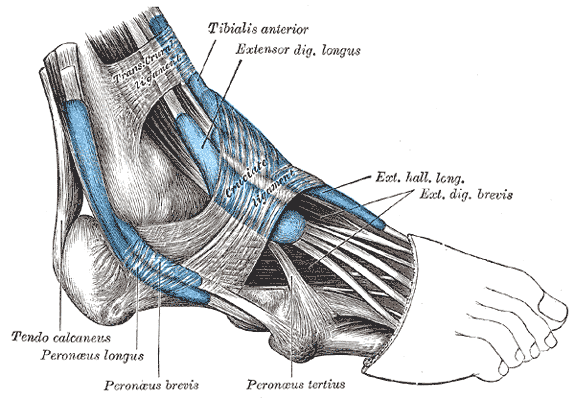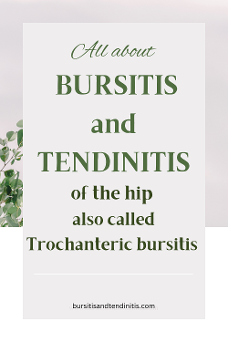Articles on Bursitis and Tendinitis
Tendinitis is inflammation or irritation of a tendon.
Tenosynovitis is tendinitis as well as inflammation of the protective covering around the tendon which is called the tendon sheath.
A tendon is like a thick cord that joins the bone to muscle in different parts of the body. It is like a rubber band, under tension. If a tendon is torn it is difficult to heal on its own.
The term tendinosis means there is tendon degeneration.
The term tendinopathy is used to describe a common condition affecting the tendons, which causes pain with or without swelling, or impaired performance. .
I personally have had tendinitis in :
-
Thumb
- Hips
Many people get tendinitis in :
-
Knees: Patellar and popliteal tendons and iliotibial band at the knee
-
Shins: Insertion of the posterior tibial tendon in the leg (ie, shin splints)
-
Heel: Achilles tendon at the heel
-
Elbow: Insertion of the wrist extensors (ie, lateral epicondylitis, tennis elbow) and flexors (ie, medial epicondylitis) at the elbow
What Is Bursitis? by Dr Nathan Wei
As baby boomers age, they become susceptible to many types of aches and pains. One of the most common afflictions is bursitis...inflammation of a bursa.
A bursa is a small sack filled with fluid. These bursae (plural of “bursa”) are located wherever tendons or ligaments move across joints, to protect the bones, tendons and muscles that surround joints. Protection by bursae comes from the ability of these sacks to cushion shock or to reduce the effects of friction during movement of a joint.
Repetitive trauma, pressure, or overuse can lead to inflammation of a bursa. Also, aging is another cause of bursal inflammation. Inflammation is the body’s response to any type of injury. When a bursa becomes inflamed, it becomes swollen due to two factors. First, the lining of the bursa thickens; then this thickened lining starts to produce more fluid. A person who develops bursitis will experience the common symptoms of inflammation which include pain, swelling, heat and possibly redness.
There are more than 150 bursae located throughout the body. The most common sites for bursitis to develop are the hips, shoulders, knees, elbows, and feet. A discussion of the various types of bursitis is in another article.
The location of the various bursae makes a diagnosis difficult when a joint becomes painful. It could be bursitis, arthritis, tendonitis, or perhaps a mixture of all three!
The diagnosis is important because the treatment is different for the three conditions… and because the diagnosis has different implications. For example, if a patient develops a painful hip, a diagnosis of arthritis possibly requiring surgery is very different from the treatment that would be administered if the diagnosis were bursitis.
A skilled rheumatologist or orthopedist can provide meaningful and expert advice when it comes to figuring out what the problem is and what to do about it.
Prevention is possibly the most important thing a patient can do. Regular low impact exercise is valuable but a person should avoid too much exercise as it can lead to overuse. Overuse then leads to bursitis. Stretching exercises are also useful for helping to avoid bursitis. Once a person has had bursitis, they are prone to developing it again so it’s important to cushion high risk areas. This involves the use of pads to protect joints or simply changing the way certain activities are done.
So what about treatment? The most important part of treatment is getting an accurate diagnosis. Most bursitis responds to simple measures such as rest, ice, and over-the-counter non-steroidal anti-inflammatory drugs (NSAIDs). Patients occasionally require a prescription-strength NSAID. Physical therapy is often useful. In cases where the bursitis fails to improve or gets worse, withdrawing fluid from the inflamed bursa and injecting steroid is warranted. Steroid injection should be administered using ultrasound guidance whenever possible. www.Isnare.com
Nathan Wei, MD FACP FACR is a rheumatologist and Director of the Arthritis and Osteoporosis Center of Maryland. He is a Clinical Assistant Professor of Medicine at the University of Maryland School of Medicine.
More information about bursitis and tendinitis
Tendinitis and Bursitis American College of Rheumatology
What is shoulder tendonitis/bursitis? The Cleveland Clinic
Exercise Your Shoulder Pain-free
Information on Bursitis and Tendinitis Center is not intended to replace the medical advice of your doctor or
health care provider. Please consult your health care provider for advice about a specific
medical condition.



